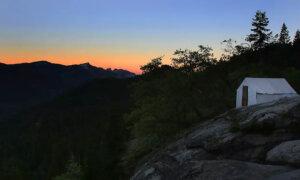SAN JOSE, Calif.—Tioga Road, the famed route through Yosemite National Park’s scenic high country and the highest-elevation road in California’s state highway system, has re-opened to vehicles.
The 46-mile-long road, which closes every winter due to deep snow, has been closed since Nov. 15. It reopened to all vehicle traffic Monday.
“It wasn’t a record, but we had a good snowpack this year,” said Scott Gediman, a Yosemite spokesman. “There’s still a lot of snow and ice around up there, but we are thrilled to get the road open. It marks the beginning of the summer season here in the park.”
On April 1, California’s statewide Sierra Nevada snowpack was 111 percent of the historical average, helping top up reservoirs around the state that were already at above-average capacity from the previous winter, when huge snowstorms ended the state’s three-year drought.
Under a pilot program aimed at reducing overcrowding in Yosemite this year, however, a reservation is required to drive into the park—and over the Tioga Road, even for visitors just passing through—on Saturdays and Sundays this month, and then every day from July 1 through Aug. 16, then on weekends and holidays only through Oct. 27. For more information go to https://www.nps.gov/yose
The Tioga Road’s opening and closing is more than a symbol of the Golden State’s shifting seasons. Doubling as State Route 120, it’s also a key route for locals and tourists traveling over the Sierra. And the length of time it takes crews to clear it provides an indication each year of how much snow the Sierra Nevada received during the winter.
Last year, after the biggest Sierra snowpack in 40 years left the Sierra snowpack at 237 percent of normal, and snow and ice on the Tioga Road more than 15 feet deep, the road didn’t reopen until July 22—breaking a record dating back 90 years, when it opened on July 8, 1933.
The average opening date from 2004 to 2023 was May 31.
To the south, across Yosemite Valley, another famous park route, Glacier Point Road, reopened this year on May 14.
Every year, crews driving snow plows with giant rotary blades clear the two roads, facing massive snow drifts and avalanche risks. At times, they use explosive charges. The work can be dangerous. In 1995, Yosemite employee Barry Hance, 43, was killed when an avalanche on Tioga Road smashed into the snow-removal machine he was driving and rolled it down the hillside.
In his memory, the park presents the Barry Hance Award every year to the park employee who best demonstrates “a positive attitude, a concern for fellow employees, a willingness to work with other divisions in the park, getting the job done, and a love for Yosemite National Park.”
“It went well this year,” Gediman said. “No injuries. No significant incidents. We appreciate the public’s patience. The high country is absolutely beautiful as always.”
Bears, deer, marmots, birds and other animals are visible across the high country now, parks officials say. But visitor facilities are still coming out of hibernation.
On Tuesday, the visitor center at Tuolumne Meadows, which sits at 8,600 feet along the road, was open. The Tuolumne Meadows store, which was damaged during extreme snow storms last year, is still being repaired and is expected to reopen in a few weeks, Gediman said.
Tuolumne Meadows campground is in the middle of a major renovation to replace an outdated water system, with plans for new restrooms, picnic tables, bear boxes and other amenities, and will be closed until next summer, he added.
One of the marquee drives in America’s national park system, the two-lane Tioga Road bisects Yosemite’s alpine center, passing through subalpine meadows and forests of lodgepole pine and juniper. It runs from Crane Flat to Tioga Pass, where it crests at 9,945 feet in the highest highway pass in California.
The route for centuries was a footpath for Miwok Indians. It was upgraded to a mining road in 1883 during a brief silver boom, and then became a private toll road that charged $2 per horse and rider.
In an unusual act of philanthropy, it became public and part of the park in 1915, when Stephen Mather, the first director of the National Park Service, bought it for $15,000 with his own money and donations from the Sierra Club and the Modesto Chamber of Commerce. He sold it to Congress that year for $10, hoping to bring more tourists into the park.








